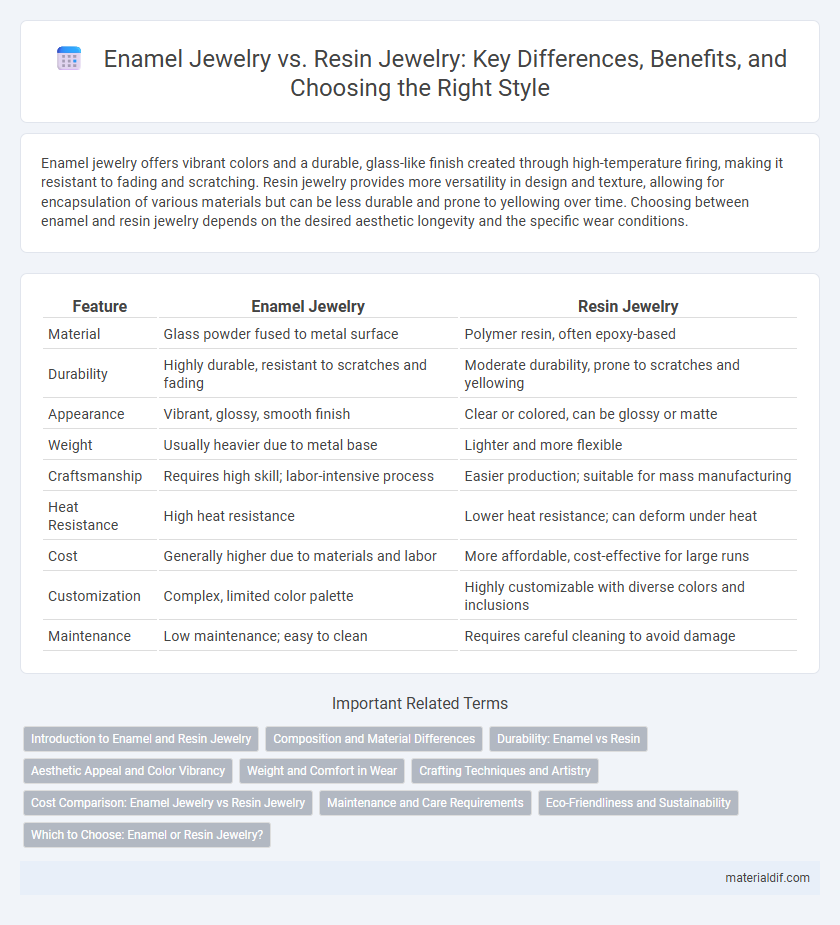Enamel jewelry offers vibrant colors and a durable, glass-like finish created through high-temperature firing, making it resistant to fading and scratching. Resin jewelry provides more versatility in design and texture, allowing for encapsulation of various materials but can be less durable and prone to yellowing over time. Choosing between enamel and resin jewelry depends on the desired aesthetic longevity and the specific wear conditions.
Table of Comparison
| Feature | Enamel Jewelry | Resin Jewelry |
|---|---|---|
| Material | Glass powder fused to metal surface | Polymer resin, often epoxy-based |
| Durability | Highly durable, resistant to scratches and fading | Moderate durability, prone to scratches and yellowing |
| Appearance | Vibrant, glossy, smooth finish | Clear or colored, can be glossy or matte |
| Weight | Usually heavier due to metal base | Lighter and more flexible |
| Craftsmanship | Requires high skill; labor-intensive process | Easier production; suitable for mass manufacturing |
| Heat Resistance | High heat resistance | Lower heat resistance; can deform under heat |
| Cost | Generally higher due to materials and labor | More affordable, cost-effective for large runs |
| Customization | Complex, limited color palette | Highly customizable with diverse colors and inclusions |
| Maintenance | Low maintenance; easy to clean | Requires careful cleaning to avoid damage |
Introduction to Enamel and Resin Jewelry
Enamel jewelry features a durable glass-like coating fused to metal through high heat, creating vibrant, long-lasting colors and intricate designs. Resin jewelry is crafted from synthetic polymer resin, allowing for lightweight, versatile pieces that can encapsulate various materials and colors with a glossy finish. Both mediums offer unique aesthetic qualities: enamel delivers classic, heat-set durability, while resin provides customizable flexibility in jewelry design.
Composition and Material Differences
Enamel jewelry is crafted by fusing powdered glass onto a metal base, creating a smooth, durable, and heat-resistant surface with vibrant, long-lasting colors. Resin jewelry, on the other hand, is made from synthetic polymers that cure into a solid, lightweight material, offering greater flexibility in embedding objects or pigments but less heat resistance. The distinct composition of enamel ensures superior scratch resistance and a glossy finish, while resin allows for more varied textures and opaque or translucent effects.
Durability: Enamel vs Resin
Enamel jewelry offers superior durability compared to resin, as its glass-like coating resists scratches, heat, and chemical exposure more effectively. Resin jewelry is more prone to yellowing, cracking, and surface wear over time due to its plastic composition. The long-term resilience of enamel makes it a preferred choice for pieces requiring lasting vibrancy and structural integrity.
Aesthetic Appeal and Color Vibrancy
Enamel jewelry offers a rich, glass-like finish with vibrant, long-lasting colors that resist fading and maintain their glossy sheen over time. Resin jewelry, while versatile and lightweight, tends to have a softer, more translucent appearance that can yellow or dull with prolonged exposure to sunlight. The high-quality pigments in enamel provide superior color depth and intensity, making it the preferred choice for bold, eye-catching designs.
Weight and Comfort in Wear
Enamel jewelry is typically lighter than resin jewelry due to its thin metal base coated with vitreous enamel, offering a comfortable and breathable wear experience. Resin jewelry, often bulkier and denser, can feel heavier on the skin, potentially causing discomfort during extended use. The lightweight nature of enamel enhances ease of wear for daily accessories compared to the substantial feel of resin pieces.
Crafting Techniques and Artistry
Enamel jewelry involves fusing powdered glass to metal surfaces at high temperatures, creating a durable, glossy finish that showcases vibrant colors and intricate designs with exceptional precision. Resin jewelry is crafted by pouring liquid resin into molds, often embedding objects or pigments, offering versatility in shapes and textures but less permanence compared to enamel's heat-set bonding. The artisanal value of enamel lies in its meticulous kiln-firing process and historical techniques, while resin emphasizes contemporary creativity through customizable inclusions and finishes.
Cost Comparison: Enamel Jewelry vs Resin Jewelry
Enamel jewelry generally incurs higher production costs due to the labor-intensive process of fusing powdered glass onto metal at high temperatures, resulting in a durable and vibrant finish. Resin jewelry is more cost-effective, as it uses inexpensive synthetic materials that cure quickly without the need for high heat, allowing for faster and cheaper mass production. When comparing cost, enamel pieces typically command premium prices due to artisanal craftsmanship, while resin jewelry offers budget-friendly options with greater design flexibility.
Maintenance and Care Requirements
Enamel jewelry requires careful handling to avoid chipping or cracking, and should be cleaned with a soft cloth and mild soap to preserve its glossy finish. Resin jewelry is more resistant to impact but can yellow or become brittle over time if exposed to direct sunlight or harsh chemicals. Both materials benefit from storage in a cool, dry place away from prolonged moisture to maintain their appearance and durability.
Eco-Friendliness and Sustainability
Enamel jewelry is often more eco-friendly than resin jewelry due to its use of natural minerals and longer durability, reducing waste over time. Resin jewelry typically involves synthetic materials and chemicals that can be less biodegradable and harder to recycle. Choosing enamel supports sustainable practices by minimizing environmental impact and promoting longevity in accessory design.
Which to Choose: Enamel or Resin Jewelry?
Enamel jewelry offers a durable, glossy finish created by fusing powdered glass to metal at high temperatures, delivering vibrant colors and long-lasting wear ideal for fine, intricate designs. Resin jewelry provides lightweight versatility with the ability to encapsulate objects, offering a wide range of textures and transparency but may yellow or scratch over time. Choosing between enamel and resin jewelry depends on priorities such as durability, aesthetic preferences, and maintenance requirements.
Enamel Jewelry vs Resin Jewelry Infographic

 materialdif.com
materialdif.com